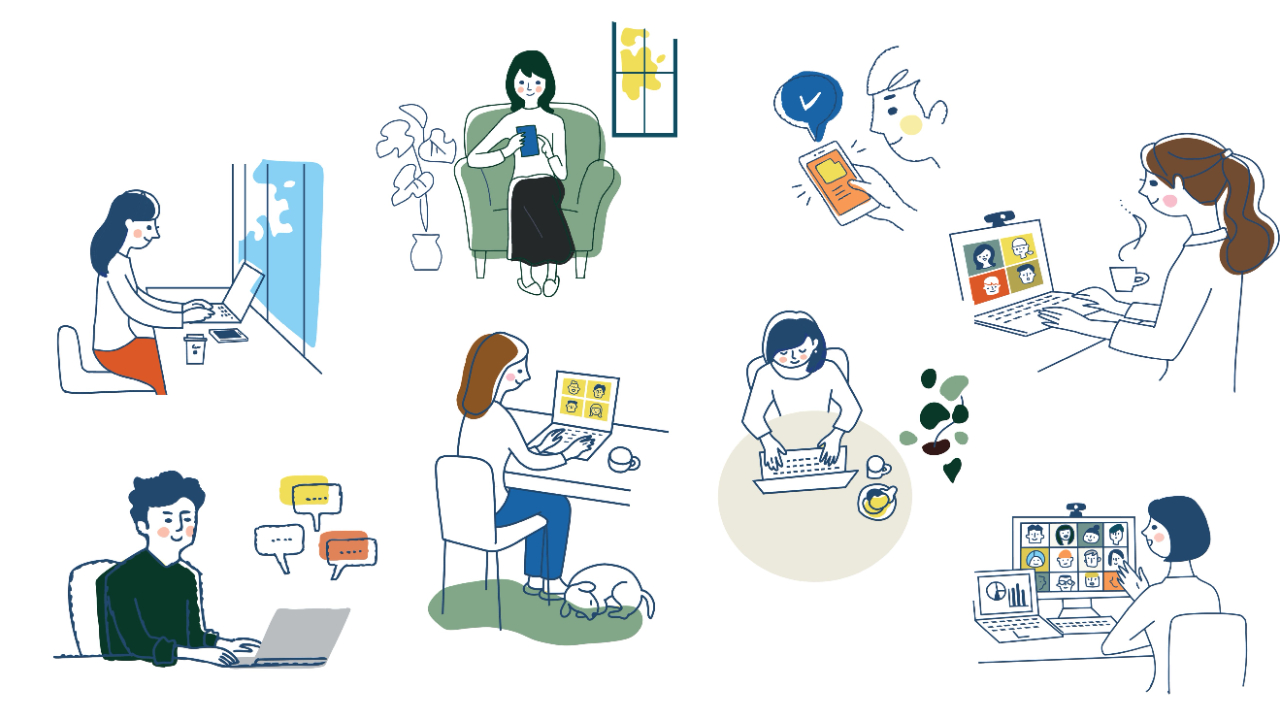Practicing Community and Connection in Remote Work
Mar 31, 2025
One of the known effects of the global COVID-19 pandemic was a huge shift in the landscape of the workforce. 2020 saw the workforce transition out of the office to fully remote work, and many companies and corporations have opted to stay there. Growing technological advancements have allowed this trend to continue, and many people now find their offices not in physical buildings but in online “workspaces”. Many studies show that this shift has been generally beneficial for the health and productivity of workers. According to Spark* Advocacy, an Ontario-based marketing agency, the “large majority of Canadians believe that remote work is good for employees (81%) and a two-thirds (66%) majority say it is also good for organizational productivity.”(1)
This does not come as a surprise to us at Naqsmist, as remote work provides more space for the protocols practiced in Cultivating Safe Spaces. Remote work cultivates space for freedom, validation, inclusion, and well-being in the workplace. Employees now see increased freedom to do the work in a way that works for them, and in-turn we see an increase in both the productivity and the well-being of workers. It has been observed “that when employees are working remotely, they are more creative, passionate, happier and more enthusiastic about their work.”(2) Numerous studies have spoken to the success of the remote work movement, citing its ability to cultivate space and freedom for people to show up to the work in ways that work for the individual.
Sharing a digital workspace with colleagues who you rarely see face-to-face, or off-Zoom, is increasingly common. While remote work has been seen to benefit the individual, it can also be seen as detrimental to teams and community structures. The isolating effects of the work-from-home movement have been studied alongside its contribution to inclusion and freedom. While remote work gives space for a more diverse and inclusive workplace, it becomes increasingly important that we continue to cultivate space to work together as teams and as communities. A group of productive individuals is not enough to make a productive team. Building relationships in a professional setting is key to the success of the team as a whole. In an article written for the Harvard Business Review, Rachel Montañez says that “high-quality connections can be made in small ways, including respectful engagement, support, trust, and playfulness”.(3)
Our team has shifted and changed shape a number of times in the past 3 years since Naqsmist Storytellers was founded. Our direction and the people behind it have changed more than once.
While our individual commitment to the work and the movement of Cultivating Safe Spaces has remained a driving force for each of us on the team, we also started to feel the effects of isolation and a lack of a common ground between roles and departments. We have spoken before about our Naqsmist Monday check-ins, where we provide updates on what we’re working on and answer the questions “How are you?”, “What do you need support with this week?” and “What’s on your heart that may impact how you show up at work?”. This tool has been key to our understanding of one another and what the team needs from one another. It gives space to discuss updates both professional and personal, and sets us up for the week in a good way. But to truly build community with one another as a team we have to not only know where someone is at, but share space with them as well.
This is why we started scheduling a weekly coworking block. We hold this meeting in the middle of each week, and have made it a priority for our team to get on a Zoom call each Wednesday for one hour to share space and work together. The coworking block is a free space to work on whatever you need to, but not in isolation. Some weeks we are all busy and the hour is spent in silence as everyone independently does their own work with the call in the background. It is also a time to ask questions and figure things out together. Some weeks it is used to bounce ideas off of one another, talk strategy, make decisions, and occasionally it is a catch-up session, more like a water-cooler chat than a working block. At the end of the day, we recognize this as another important piece of the work. The more we understand each other and can share space, the better we can work together and the less lonely remote work feels. Our team lives all across B.C., and getting together in person is a rare treat. The weekly coworking block makes us feel like we are not working in isolation, but as a part of a team, a community, and a movement bigger than ourselves.
(1) Anderson, Bruce. (2024). Most Canadians think flexible work arrangements are good both for productivity, and for employees. spark*insights. https://www.sparkadvocacy.ca/insights/2024/09/most-canadians-think-flexible-work-arrangements-are-good-both-for-productivity-and-for-employees?utm_medium=website&utm_source=newswire&utm_title=most-canadians-think-flexible-work-arrangements-are-good-both-for-productivity-and-for-employees
(2) Ibid.
(3) Montañez, R. (2024, March 22). Fighting loneliness on remote teams. Harvard Business Review. https://hbr.org/2024/03/fighting-loneliness-on-remote-teams
